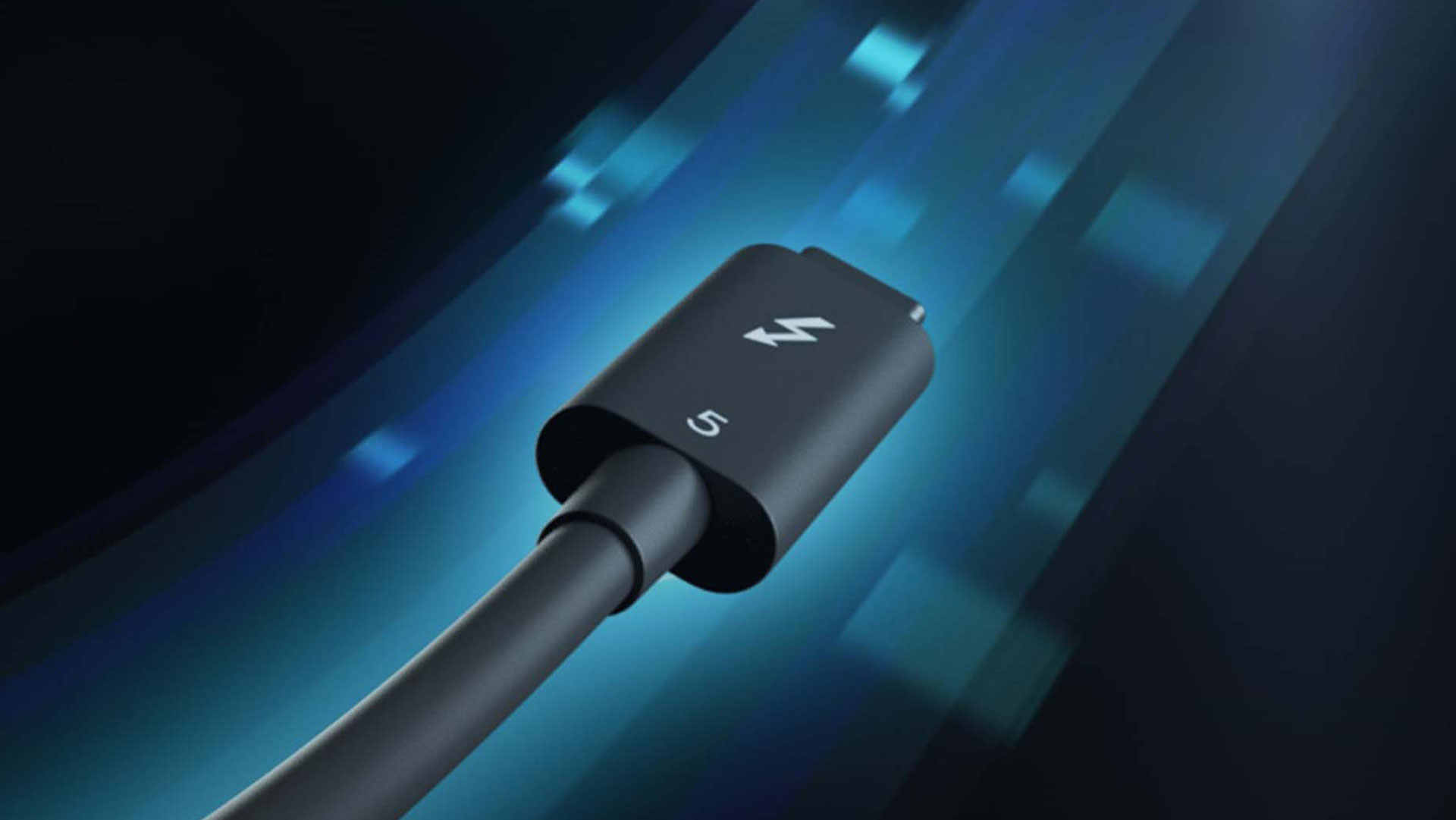14th Gen Intel Core Desktop CPUs Don't Support Thunderbolt 5
Intel had to correct the record, but some other 14th Gen CPUs will get support.

Intel launched its 14th Gen "Raptor Lake Refresh" desktop processors earlier this week, including the Intel Core i9-14900K, i7-14700K and i5-14600K. Upon the announcement, Intel initially stated that 14th Core desktop chips would support Thunderbolt 5, the latest version of the specification. But Intel has now said that while some 14th gen chips will work with Thunderbolt 5, that's not the case for these desktop chips.
"While some processors in the Intel Core 14th Gen processor family will include support for Thunderbolt 5, Intel Core 14th Gen desktop processors, specifically, will not support it," an editors' note appended to Intel's initial announcement reads. "The Intel Core 14th Gen launch announcement incorrectly said, 'Intel Core 14th Gen desktop processors include support for … upcoming Thunderbolt 5 wired connectivity – supporting up to 80 Gbps of bi-directional bandwidth.' Intel will share additional details on Intel Core 14th Gen CPUs that support Thunderbolt 5 at a later date."
To some degree, this isn't a huge surprise. The Raptor Lake Refresh chips are just that — refreshes and the underlying design is the same as 13th Gen but optimized for better performance. So it's not exactly shocking that Intel didn't go in and add support for Thunderbolt 5 on desktops.
Without desktop processors supporting Thunderbolt 5, it seems that where we'll see the new connection spec is on laptops, probably on the Intel Core Ultra "Meteor Lake" chips. Thunderbolt 4 (and previous versions of Thunderbolt) have been far more prolific on mobile devices with Intel chips than on desktop. There isn't a huge variety of desktop motherboards featuring the port. (Getting into machines with AMD chips is another bag of worms.)
Intel gave the Thunderbolt specification to the USB-IF standards committee. As deputy managing editor Paul Alcorn explained when Thunderbolt 5 was announced, "Thunderbolt 5 leverages the foundational aspects of the latest USB specification, USB 4 Version 2.0 in this case, but requires that all of the optional features be enabled to earn the Thunderbolt 5 badge."
Thunderbolt 5 has an evenly distributed 80 Gbps of bandwidth to transmit and receive data at the same rate. However, when there are higher display bandwidth needs, it can boost to 120 Gbps transmitting, making it faster than DisplayPort 2.1. Thunderbolt 5 can support up to two 6K monitors and three 4K monitors at 144 Hz, along with the option for 8K HDR.
Additionally, Thunderbolt 5 cables will support up to 240W charging on laptops. You can learn the latest specs features at our rundown of the announcement from earlier this year.
Get Tom's Hardware's best news and in-depth reviews, straight to your inbox.

Andrew E. Freedman is a senior editor at Tom's Hardware focusing on laptops, desktops and gaming. He also keeps up with the latest news. A lover of all things gaming and tech, his previous work has shown up in Tom's Guide, Laptop Mag, Kotaku, PCMag and Complex, among others. Follow him on Threads @FreedmanAE and BlueSky @andrewfreedman.net. You can send him tips on Signal: andrewfreedman.01
-
HaninTH 240 watts ain't bad, but 280 or an even 300 would be better, as the Z Book i'm on now REQUIRES a 280 watt supply to not constantly nag of running with an under powered power adapter/dock.Reply
We need more powah, babeh!
Oh yeah, I also forgot to mention this i7-12800H is a furnace, idling at 130F in a 70F room with the entire device weighing in at near 5lbs. Insanity, what qualifies as an "ultrabook". -
DavidLejdar Reply
Yeah, 100W over USB-C (with 5A) isn't much for some laptops. When a laptop requires more than 100W, it usually comes with a power adapter supporting e.g. 150W or 200W though. And using that may not be as cool as charging with USB-C, but it is a viable solution.HaninTH said:240 watts ain't bad, but 280 or an even 300 would be better, as the Z Book i'm on now REQUIRES a 280 watt supply to not constantly nag of running with an under powered power adapter/dock.
We need more powah, babeh!
Oh yeah, I also forgot to mention this i7-12800H is a furnace, idling at 130F in a 70F room with the entire device weighing in at near 5lbs. Insanity, what qualifies as an "ultrabook".
Another issue can be the docking station though. Some do not even deliver 100W, or do not have that a high total to support also i.e. two screens hooked up, running at some 240 Hz. In such case, lowering the refresh rate can help, and it won't really show when using the laptop/screens for office work only.
As for high temp on idle CPU, you may want to check if disabling the Intel Boost will lower that. Depending on what applications you use, you may not want to miss out on that boost in some cases. But if the CPU is applying that Boost even when idle, I would check if disabling it lowers the idle temp, and if I really need it. And in case it is not needed, disabling it would also lower the power draw of the laptop, perhaps even so much that the previous issue solves itself. -
InvalidError Reply
I'd be nervous about having 600mV signal lines next to 48+V power. I think we really need a new, clean high-speed, high-power cable spec with optical data, optional 12/24/48V power at up to 10A. Then we shouldn't need any more new cables until we need 10+Tbps of bandwidth, at which point we may need multi-core connections to keep transceiver cost reasonable.HaninTH said:240 watts ain't bad, but 280 or an even 300 would be better, as the Z Book i'm on now REQUIRES a 280 watt supply to not constantly nag of running with an under powered power adapter/dock. -
bit_user ReplyGetting into machines with AMD chips is another bag of worms.
Gross... talk about mixing metaphors! I doubt you'd have worms in a bag - at least not intentionally. Bait shops sell them in hard containers (traditionally cans, I suppose), presumably so you don't unintentionally smash them and make a big mess.
Thunderbolt 5 has an evenly distributed 80 Gbps of bandwidth to transmit and receive data at the same rate. However, when there are higher display bandwidth needs, it can boost to 120 Gbps transmitting
Uh, so I guess you mean that it has symmetrical bandwidth ...until it doesn't. -
bit_user Reply
True idle? Like 0% CPU usage, in Task Manager? Or just idle in that you're not running any foreground apps? My corporate laptop almost never truly idles. There's usually something chewing up some background cycles, it seems. Anyway, I wouldn't be too concerned about an idle temperature of 54 C. These CPUs are made to withstand a lot of heat. You could tweak your fan curves, but cooling it more than necessary will just waste battery power.HaninTH said:Oh yeah, I also forgot to mention this i7-12800H is a furnace, idling at 130F in a 70F room with the entire device weighing in at near 5lbs. Insanity, what qualifies as an "ultrabook".
The bigger issue I have is that even when I set Windows to maximum power saving mode, I don't even get like 3 hours of charge out of a fairly new Dell Precision laptop, simply running a web browser or MS Teams. If Intel doesn't really improve on efficiency, they're probably going to lose more of the laptop segment. Right now, I would not buy an Intel laptop, if I really needed good battery life. I'm not one to go for a Mac, but I think a lot of people would.
In my opinion, the best option is to tweak the PL (Power Limit) settings, using a tool like ThrottleStop. However, I would only do this to combat fan noise or extend battery life. During the summer, I used it to reduce the amount of heat the laptop would pump into the room. CPU temperatures aren't necessarily a problem, by themselves.DavidLejdar said:As for high temp on idle CPU, you may want to check if disabling the Intel Boost will lower that.
I feel this. Mine definitely seems heavier than it should be.HaninTH said:the entire device weighing in at near 5lbs. Insanity, what qualifies as an "ultrabook". -
bit_user Reply
I hate feeding the credit card companies for the minimal services they provide, but the protections of buying on credit are a safety net I wouldn't give up on any major purchase.Tom Sunday said:The big picture here however remains that people do not want to pay sales tax nor pay MSRP. Buying over the folding tables at the show also saves another 5% if paying with cash! Greetings from the man on the street!
Just remember that whatever rewards or cash back you're getting from your credit card - that's essentially a portion of your own money that's being handed back to you, as a bribe to keep using it! If the payment card industry could be more effectively regulated, we wouldn't see such practices - but the sticker prices on merchandise would fall by more than you'd lose in rewards - ultimately saving you more money, in the end. -
purpleduggy still waiting for stingy motherboard manufacturers to even include thunderbolt 4/usb4 40Gbps, a $15 chip. they think usb 3 is still fast enough. even on a z790 or X670 they still do this. usb4/thunderbolt 4 should be everywhere.Reply -
junglist724 It's not like any desktop cpu supports thunderbolt of any kind. You always have to get an add in card with a thunderbolt controller or a motherboard with one integrated.Reply -
InvalidError Reply
If it adds $15 per port, I think there will be no shortage of people who think it isn't worth $15 extra for how little actual uses there are for it on the desktop where everything can have its own dedicated high-speed interface. It mostly makes sense on laptops where you are space-limited in the amount of USB, HDMI, DP, power, etc. ports you can have.purpleduggy said:usb4/thunderbolt 4 should be everywhere.
I don't own any 3.x-gen2 devices yet, 3.x-gen1 is fast enough for my external storage needs and I won't be bothering with 3.x-gen2 until the price premium over 3.x-gen1 is mostly gone. USB4-gen2/TB5 is a looong way down the line for me, possibly into "never going to bother" territory. -
purpleduggy Reply
its not a luxury connection. thunderbolt has been out for over a decade. the only way to get nvme speeds externally is to use thunderbolt/usb4junglist724 said:It's not like any desktop cpu supports thunderbolt of any kind. You always have to get an add in card with a thunderbolt controller or a motherboard with one integrated.